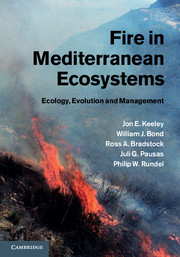Book contents
- Frontmatter
- Contents
- Section I Introduction
- Section II Regional patterns
- Section III Comparative Ecology, Evolution and Management
- 9 Fire-adaptive Trait Evolution
- 10 Fire and the Origins of Mediterranean-type Vegetation
- 11 Plant Diversity and Fire
- 12 Alien Species and Fire
- 13 Fire Management of Mediterranean Landscapes
- 14 Climate, Fire and Geology in the Convergence of Mediterranean-type Climate Ecosystems
- References
- Index
12 - Alien Species and Fire
from Section III - Comparative Ecology, Evolution and Management
Published online by Cambridge University Press: 05 January 2012
- Frontmatter
- Contents
- Section I Introduction
- Section II Regional patterns
- Section III Comparative Ecology, Evolution and Management
- 9 Fire-adaptive Trait Evolution
- 10 Fire and the Origins of Mediterranean-type Vegetation
- 11 Plant Diversity and Fire
- 12 Alien Species and Fire
- 13 Fire Management of Mediterranean Landscapes
- 14 Climate, Fire and Geology in the Convergence of Mediterranean-type Climate Ecosystems
- References
- Index
Summary
A large diversity of alien plants is found in most mediterranean-type climate (MTC) regions and fire is sometimes closely linked to their ability to invade natural ecosystems. This is a concern because aliens often upset natural ecosystem processes, and thus are a major management concern. These five regions not only differ in their contributions of non-native plant species to other regions, but also vary in their susceptibility to invasion by alien species, something often referred to as a community's invasibility.
Fire is a key factor behind plant invasions into natural plant communities and particularly critical is the timing of propagule availability and characteristics of the fire regime. Fire also interacts with geology in dictating functional types that become pernicious invasive problems. For example, on coarse-textured low-fertility soils in two of the southern hemisphere MTC regions, shrubs and trees are among the most aggressive invasives, and are capable of invading seemingly undisturbed intact shrublands. However, on more fertile soils such as in California and Chile, grasses and other herbaceous species are bigger threats, but invasion typically requires disturbance and under some circumstances fire can effect type conversion from woody vegetation to alien-dominated grasslands.
- Type
- Chapter
- Information
- Fire in Mediterranean EcosystemsEcology, Evolution and Management, pp. 330 - 348Publisher: Cambridge University PressPrint publication year: 2011



